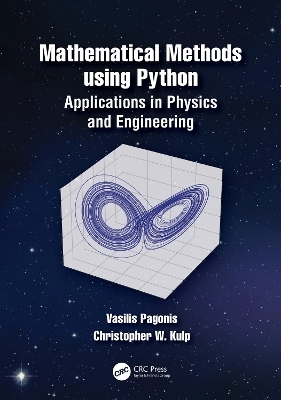
Mathematical Methods using Python
CRC Press (Verlag)
978-1-032-27836-0 (ISBN)
An introductory chapter gives students a crash course in Python programming and the most often used libraries (SymPy, NumPy, SciPy, Matplotlib). This is followed by chapters dedicated to differentiation, integration, vectors and multiple integration techniques. The next group of chapters covers complex numbers, matrices, vector analysis and vector spaces. Extensive chapters cover ordinary and partial differential equations, followed by chapters on nonlinear systems and on the analysis of experimental data using linear and nonlinear regression techniques, Fourier transforms, binomial and Gaussian distributions. The book is accompanied by a dedicated GitHub website, which contains all codes from the book in the form of ready to run Jupyter notebooks. A detailed solutions manual is also available for instructors using the textbook in their courses.
Key Features:
A unique teaching approach which merges mathematical methods and the Python programming skills which physicists and engineering students need in their courses
Uses examples and models from physical and engineering systems, to motivate the mathematics being taught
Students learn to solve scientific problems in three different ways: traditional pen-and-paper methods, using scientific numerical techniques with NumPy and SciPy, and using Symbolic Python (SymPy).
Vasilis Pagonis is Professor of Physics Emeritus at McDaniel College, Maryland, USA. His research area is applications of thermally and optically stimulated luminescence. He taught courses in mathematical physics, classical and quantum mechanics, analog and digital electronics and numerous general science courses. Dr. Pagonis’ resume lists more than 200 peer-reviewed publications in international journals. He is currently associate editor of the journal Radiation Measurements. He is co-author with Christopher Kulp of the undergraduate textbook “Classical Mechanics: a computational approach, with examples in Python and Mathematica” (CRC Press, 2020). He has also co-authored four graduate level textbooks in the field of luminescence dosimetry, and most recently published the book “Luminescence Signal analysis using Python” (Springer, 2022). Christopher Kulp is the John P. Graham Teaching Professor of Physics at Lycoming College. He has been teaching undergraduate physics at all levels for 20 years. Dr. Kulp’s research focuses on modelling complex systems, time series analysis, and machine learning. He has published 30 peer-reviewed papers in international journals, many of which include student co-authors. He is also co-author of the undergraduate textbook “Classical Mechanics: a computational approach, with examples in Python and Mathematica” (CRC Press, 2020).
Chapter 1: Introduction to Python. Chapter 2: Differentiation. Chapter 3: Integration. Chapter 4: Vectors. Chapter 5: Multiple Integrals. Chapter 6: Complex Numbers. Chapter 7: Matrices. Chapter 8: Vector Analysis. Chapter 9: Vector Spaces. Chapter 10: Ordinary Differential Equations. Chapter 11: Partial Differential Equations. Chapter 12: Analysis of Nonlinear Systems. Chapter 13: Analysis of Experimental Data. Further Reading and Additional Resources. Index.
| Erscheinungsdatum | 19.04.2024 |
|---|---|
| Zusatzinfo | 16 Tables, black and white; 119 Line drawings, black and white; 7 Halftones, black and white; 126 Illustrations, black and white |
| Verlagsort | London |
| Sprache | englisch |
| Maße | 178 x 254 mm |
| Gewicht | 453 g |
| Themenwelt | Mathematik / Informatik ► Informatik ► Programmiersprachen / -werkzeuge |
| Mathematik / Informatik ► Informatik ► Theorie / Studium | |
| Mathematik / Informatik ► Mathematik ► Angewandte Mathematik | |
| Naturwissenschaften ► Biologie | |
| ISBN-10 | 1-032-27836-6 / 1032278366 |
| ISBN-13 | 978-1-032-27836-0 / 9781032278360 |
| Zustand | Neuware |
| Haben Sie eine Frage zum Produkt? |
aus dem Bereich


